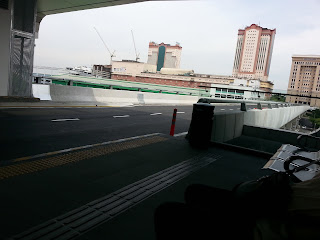JLPT test info
It's been a while since I posted anything. I was busy with my internship and some stuff and was outstation for more than a week, which is why no post for a few weeks. And now, since my internship is going to over (like finally?), I have a little time for this and I wanted to share my experience of taking JLPT N5 test on the 6th of December.
Apparently, JLPT test happens twice a year, which is July and December (usually on Sunday). The registration is opened 3 months before the test and ends about 13 days after the registration starts (I am not sure if it changes every year), so be sure to be quick. You don't want to wait for another year. This test is not restricted by age and you don't have to belong to any language institutions in order to take this test. Also, you can skip a level (e.g not taking N5 and straight away taking N4) if you think you have the confidence to pass that level.
The applicants are allowed to choose the venue of the test - Kuala Lumpur, Penang, Ipoh, Kota Kinabalu and Johor Bahru. So, I chose the nearest to where I live, which is KL. The payment for each level is as follow (again, I am not sure if it changes every year):
N1 - N2: RM 120
N3: RM 100
N4 - N5: RM 80
You can register for the test online: http://jlpt.jlsm.org/RegistrationNotice.aspx. It has a clear guidelines of the whole process, so read it before you start the registration.
Enough of introduction of JLPT, now the test day! During the test day, what you need to bring are test voucher, IC and your own writing utensils, mainly pencils and erasers. For applicants who choose to have the test in KL, the venue would be in Confucian Private Secondary School. On that day, I arrived about an hour earlier, took my breakfast and straight to the test venue. I was surprised that there was no registration required, which was quite different when I took the Monbukagakusho Scholarship test then. So, I just had to check my sit and enter the hall. The sitting arrangement was placed right outside the main hall. Make sure to check it out.
Once entered the hall, we were required to switch off our handphones or turn into silent mode. Apparently, they will kick you out of the hall if your phone rang. Bags and bottles were to put on the floor. About 10 or 5 minutes before the commencement of the test, they gave out a set of multiple questions answer sheet and we were told to check the particulars (Names, IC,...) that are printed on them. Then, they gave out the questions sheets and we were told to check them. When the clock stroke exactly the stated time, the test began (No joking, it is exactly the stated time).
For N5, we started with vocabulary test. The test took 25 minutes. Basically, for this test, they test your kanji, katakana and hiragana. There were 4 sections:
1st - understanding of the kanji.
2nd - test on your katakana and hiragana. For example, they give you a word in katakana, then you have to convert it to hiragana or vice versa.
3rd - vocabulary
4th - sentence with similar meaning. They will give you a sentence, then you will have to find a sentence that has a similar meaning to the question given.
After the first test, we had a 30 minutes break. However, we had to enter the hall 10 minutes before the test started, which made it to about 20 minutes. Well, either way, it was more than enough. After the vocabulary test, it was grammar and reading test. The test took 50 minutes. For this test, it had more sections:
1st - test on particles
2nd - arranging the sentence
3rd - test on your usage of present and past tense
4th - 6th - reading and understanding the passages or diagrams
After another 30 minutes break, the listening test began, which took 30 minutes. Before the test commenced, they tested the sound system to ensure that everyone is able to listen clearly. Don't worry to those who plan to take their test in KL, the school's sound system is loud enough for those who sit at the far back. For the listening test, it is either, listening while looking at the pictures provided or by just listening and answer the questions.
For every test, from vocabulary to listening, examples are given for each section. So, even if you have never tried the sample tests in the websites or attended any extra classes, you are most likely able to understand the questions. To access the sample test, you can visit JLPT's website. The sample questions given by them are exactly the kind of questions they are going to ask, unless they are going to change the format.
The test is done in a very strict manner. Fails to attend any section of the test means you fail the whole test. So, be sure to follow the rules. Good luck and all the best!!



Comments
Post a Comment